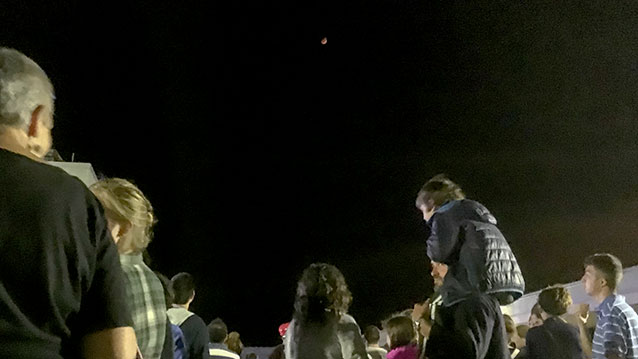EVANSTON, Ill. --- Northwestern University provided the telescopes, and more than 1,700 people – students, faculty, staff and community members -- turned out Sunday night to view the total lunar eclipse of the supermoon atop the Segal Visitors Center Parking Garage.
“This was the largest public observing event that I have helped run since coming to Northwestern in 2003,” observed Michael Smutko, a professor of instruction in physics and astronomy in the Weinberg College of Arts and Sciences. “Our previous record was about 900 people for the Transit of Venus in 2012.”
Three large telescopes were set up for visitors. Faculty, postdoctoral fellows and graduate and undergraduate students from Northwestern’s Center for Interdisciplinary Exploration and Research in Astrophysics (CIERA) were on hand to answer questions and operate the telescopes.
Clouds rolled in at times to obscure the view of the moon, which turned a dark, reddish hue during the total eclipse due to the the alignment of the moon, Earth and sun. The eclipse occurred during a time when the moon was a supermoon, a moon that appears larger and brighter than normal due to its closeness to Earth. The combination made it a spectacular celestial show.
Total lunar eclipses are fairly rare, occurring when the entire moon moves into the Earth’s shadow. Over the course of a few hours, the moon changes from a bright full moon to a dark reddish or coppery-colored moon – and then slowly back to its former color and brightness.
Smutko was pleased so many turned out for the special viewing event on Northwestern University’s Evanston campus, which was open to the public.
“I think that this event was popular because of the timing and the weather,” he said Monday. “It began soon after dark, so it wasn’t too late for families, and the weather was nice and warm—a good night to be out. The next total lunar eclipse visible from Chicago will be in January 2019, and just based on the fact that it will be in January, I don’t think we will get as big of a turnout.”
The free public event was held from 8 to 11:30 p.m. on the top level of the Segal Visitors Center Parking Garage, 1847 Campus Drive. The eclipse began at 8:07 p.m. and ended at 11:27 p.m. The moon was totally eclipsed for about an hour and 12 minutes of that time.
“This is a chance to witness how the Earth, moon and sun are all connected,” Smutko said before the event. “The three must be aligned to form a straight line, so the Earth’s shadow completely envelops the moon, for a total lunar eclipse.”
CIERA and the Dearborn Observatory regularly hold a variety of outreach events connecting the public to astronomical events and astronomers. Last October, close to 200 people gathered atop the same parking garage to safely view a partial solar eclipse.


